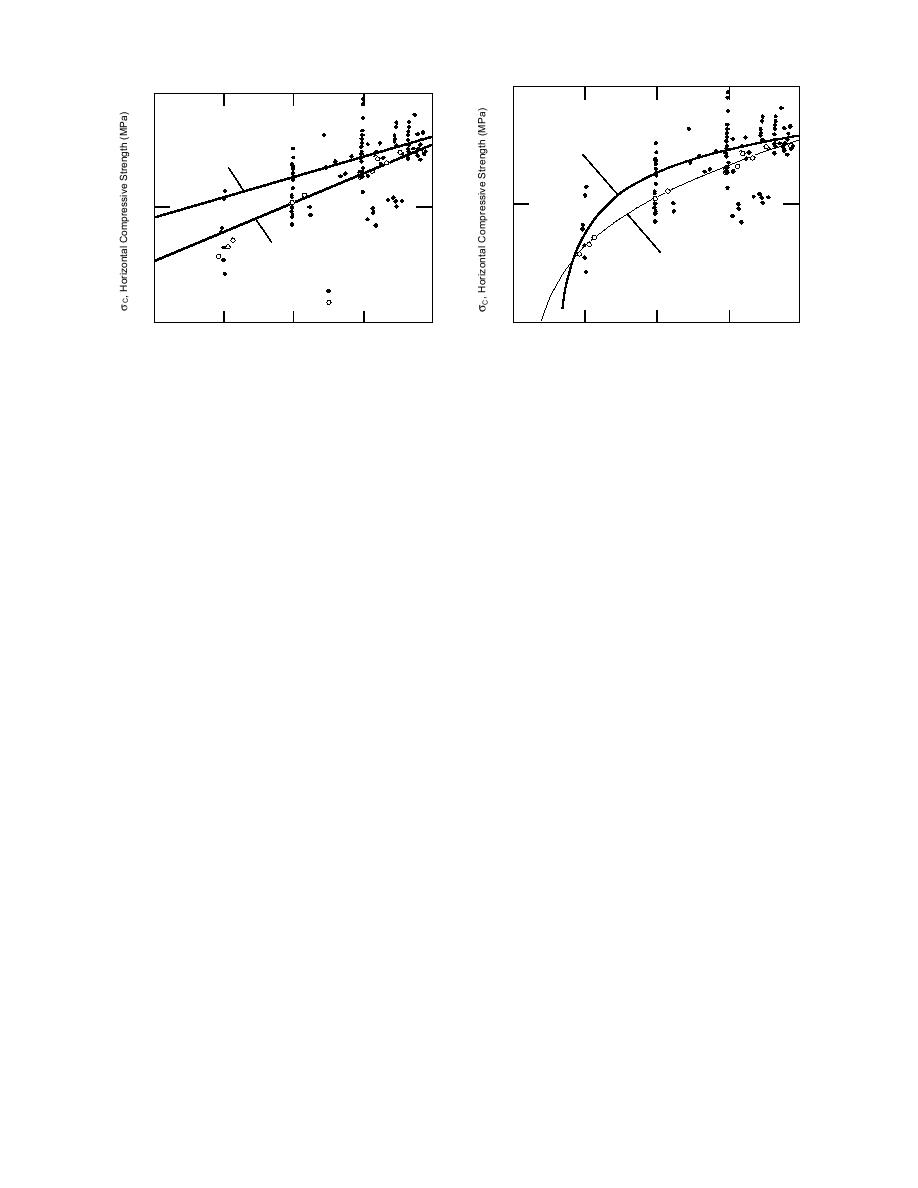
1
10
1
10
0.07
σ C = 8.76 2.98ε
r 2 = 0.280
0.177
σC = 14.07ε
S D = 1.43
r 2 = 0.261
S D = 1.44
0
10
10 0
σC= 23.02 ε
0.263
0.14
σ C = 1.43 + 12.93ε
r 2 = 0.958
S D = 0.22
r 2 = 0.972
S D = 0.18
Sanderson (1988)
This Study
1
1
10
10
7
6
5
4
3
10 7
10 6
10 5
10 4
10 3
10
10
10
10
10
ε
ε, Strain Rate (s 1 )
, Strain Rate (s 1 )
Figure 21. Ice floe σc values calculated using eq 8 from
Figure 20. Ice floe σc values calculated using eq 8 from
this study compared with the data provided by Sanderson
the study compared with the data provided by
(1988). The data were fitted with non-log-log power
Sanderson (1988). The data were fitted with a single-
equations.
term power equation.
-
presentation, no corrections have been made to
σc = 1970 ε0.32 φB0.95 .
˙
(10)
the data to account for differences in test tech-
nique, ice porosity, grain size, or crystal orienta-
In the boresight view of the data from the strain
tion. This is not unusual since some of these pa-
rate window in Figure 22b, the "outlier" with
rameters were not measured or provided in the
the long offset tail at a strain rate of 7.9 107s1
original source material, as is the case for the
is very apparent. However, removing this data
Exxon data used in this report. For this reason
point and reanalyzing the remaining data gives
there is considerable scatter in the data. The up-
a new equation whose calculated σc values do
per regression curve shown in Figure 20 fits the
not vary by more than 0.04 MPa from those cal-
data from Sanderson; the lower curve represents
culated by eq 10.
the data generated from eq 8. The small amount
The form of the expression for the curved fail-
of data from this study coupled with the un-
ure surface shown in Figure 17 does not fit the
knowns mentioned above does not allow a defini-
new data set as well as the power type equation
tive statement to be made on the difference be-
in Figure 22. This may be seen by comparing the
tween the two lines. Clearly, the data from this
statistics listed in Figure 22 with those in Figure
study fit well within the scatter of the data from
23. The boresight view of the failure plane from
Sanderson. Both sets of data are statistically bet-
the strain rate window (Fig. 23b) also indicates no
ter represented by the nonlinear curves shown in
fit improvement for the outlier over the failure
Figure 21. Here again, the failure surface appears
surface shown in Figure 22b.
to be a non-power-law function of the strain rate.
Substituting the new νB data for the φB data
The Timco and Frederking (1990) study, which
and reanalyzing as before gives the results shown
resulted in the formulation of eq 6, is based on
in Figure 24. The expression for the failure surface
small-scale test results. How applicable this equa-
is now
tion is to full-scale ice force assessments can be
-
σc = 523.24 ε 0.32 νB0.67 .
questioned on the basis of small- to large-scale
˙
(11)
scaling uncertainties. To avoid this problem, the
full-scale Exxon σc data were directly analyzed
As with the bulk porosity data, applying a curved
failure surface through the σc vs. bulk brine vol-
using the values listed in the right-hand bulk po-
ume and ε data does not result in a statistically
˙
rosity column in Table 3. Applying eq 9 to analyze
the σc and ε data of Exxon vs. the above-related
˙
better curve fit.
φB values (Fig. 22a) gives the following expres-
It is interesting that the σc vs. ε trend, as ob-
˙
sion for the failure surface:
tained with eq 8 and from Sanderson's data, ap-
12



 Previous Page
Previous Page
